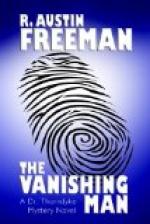“Yes; evidently parts of a dismembered body.”
“So I should suppose. No, I have not followed the accounts. As we get on in life our interests tend to settle into grooves, and my groove is chiefly connected with conveyancing. These discoveries would be of more interest to a criminal lawyer.”
“I thought that you might, perhaps, have connected them with the disappearance of your client.”
“Why should I? What could be the nature of the connection?”
“Well,” I said, “these are the bones of a man—”
“Yes; and my client was a man with bones. That is a connection, certainly, though not a very specific or distinctive one. But perhaps you had something more particular in your mind.”
“I had,” I replied. “The fact that some of the bones were actually found on land belonging to your client seemed to me rather significant.”
“Did it, indeed?” said Mr. Jellicoe. He reflected for a few moments, gazing steadily at me the while, and then continued: “In that I am unable to follow you. It would have seemed to me that the finding of human remains upon a certain piece of land might conceivably throw a prima facie suspicion upon the owner or occupant of that land as being the person who deposited them. But the case that you suggest is the one case in which this would be impossible. A man cannot deposit his own dismembered remains.”
“No, of course not. I was not suggesting that he deposited them himself, but merely that the fact of their being deposited on his land, in a way, connected these remains with him.”
“Again,” said Mr. Jellicoe, “I fail to follow you, unless you are suggesting that it is customary for murderers who mutilate bodies to be punctilious in depositing the dismembered remains upon land belonging to their victims. In which case I am sceptical as to your facts. I am not aware of the existence of any such custom. Moreover, it appears that only a portion of the body was deposited on Mr. Bellingham’s land, the remaining portions having been scattered broadcast over a wide area. How does that agree with your suggestion?”
“It doesn’t, of course,” I admitted. “But there is another fact that I think you will admit to be more significant. The first remains that were discovered were found at Sidcup. Now, Sidcup is close to Eltham; and Eltham is the place where Mr. Bellingham was last seen alive.”
“And what is the significance of this? Why do you connect the remains with one locality rather than the various other localities in which other portions of the body have been found?”
“Well,” I replied, rather gravelled by this very pertinent question, “the appearances seem to suggest that the person who deposited these remains started from the neighbourhood of Eltham, where the missing man was last seen.”
Mr. Jellicoe shook his head. “You appear,” said he, “to be confusing the order of deposition with the order of discovery. What evidence is there that the remains found at Sidcup were deposited before those found elsewhere?”




